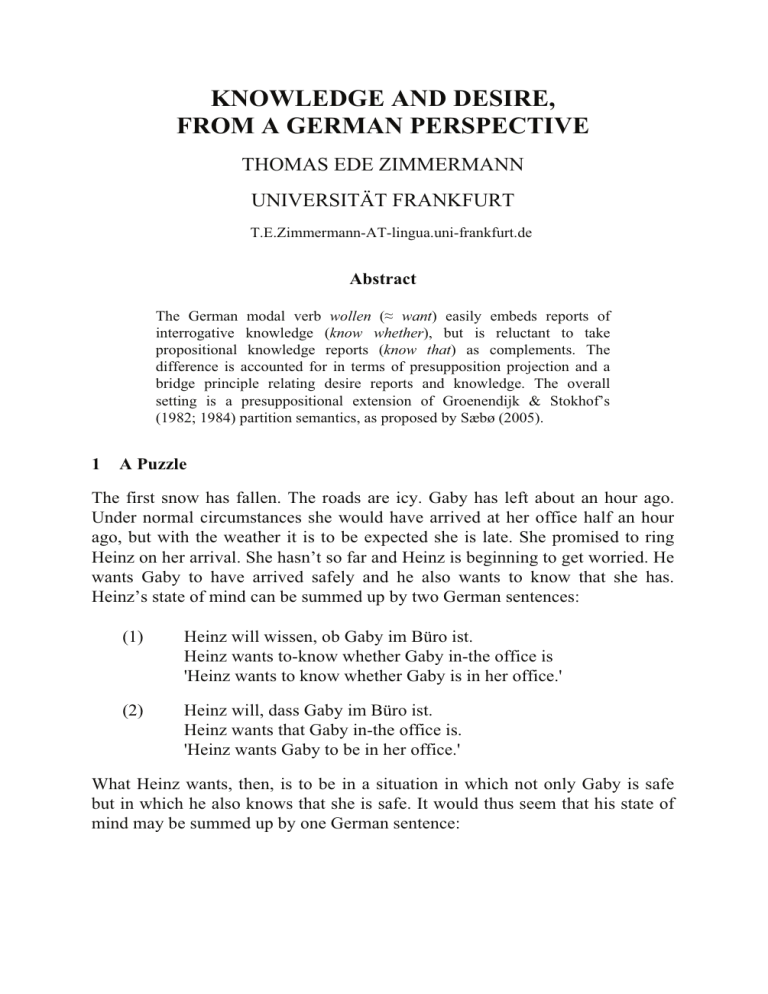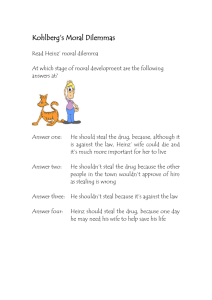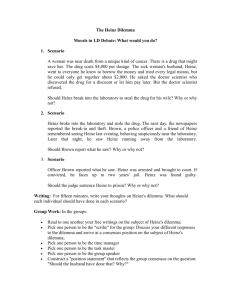KNOWLEDGE AND DESIRE, FROM A GERMAN PERSPECTIVE

KNOWLEDGE AND DESIRE,
FROM A GERMAN PERSPECTIVE
THOMAS EDE ZIMMERMANN
UNIVERSITÄT FRANKFURT
T.E.Zimmermann
-ATlingua.uni-frankfurt.de
Abstract
The German modal verb wollen ( § want ) easily embeds reports of interrogative knowledge ( know whether ), but is reluctant to take propositional knowledge reports ( know that ) as complements. The difference is accounted for in terms of presupposition projection and a bridge principle relating desire reports and knowledge. The overall setting is a presuppositional extension of Groenendijk & Stokhof’s
(1982; 1984) partition semantics, as proposed by Sæbø (2005).
1 A Puzzle
The first snow has fallen. The roads are icy. Gaby has left about an hour ago.
Under normal circumstances she would have arrived at her office half an hour ago, but with the weather it is to be expected she is late. She promised to ring
Heinz on her arrival. She hasn’t so far and Heinz is beginning to get worried. He wants Gaby to have arrived safely and he also wants to know that she has.
Heinz’s state of mind can be summed up by two German sentences:
(1)
(2)
Heinz will wissen, ob Gaby im Büro ist.
Heinz wants to-know whether Gaby in-the office is
'Heinz wants to know whether Gaby is in her office.'
Heinz will, dass Gaby im Büro ist.
Heinz wants that Gaby in-the office is.
'Heinz wants Gaby to be in her office.'
What Heinz wants, then, is to be in a situation in which not only Gaby is safe but in which he also knows that she is safe. It would thus seem that his state of mind may be summed up by one German sentence:
Thomas Ede Zimmermann
(3) Heinz will wissen, dass Gaby im Büro ist.
Heinz wants to-know that Gaby in-the office is.
'Heinz wants to know that Gaby is in her office.'
However, (3) does not express a consequence of (1) and (2), and it is not an appropriate way to describe the situation either. To the extent that (3) is appropriate at all, it has an entirely different meaning, due to an ersatz interpretation of will as meaning something close to claim . In the present note, I will ignore the latter phenomenon altogether
1
and pretend that (3) is simply illformed, be it for syntactic, semantic, or pragmatic reasons. And I will seek a semantic explanation .
When it comes to marking an expression inappropriate, two kinds of semantic explanation spring to mind. First, the expression might fail to express any content. This happens if its (semantic) presuppositions are jointly unsatisfiable, e.g. because some selectional constraint is violated. Alternatively, the content of the expression might be useless in one way or other. This happens if it is obviously redundant or, in the case of a sentence, clearly contradictory.
Although the latter account of oddity in terms of information value may be a far cry from a full explanation – after all, we do speak redundantly once in a while, and we may use obvious contradictions, albeit not in a literal way – if the case can be made that an ill-formed expression would have had a neurotic content, this might give a clue for why it is ruled out on syntactic grounds.
2 A Failed Attempt
2.1 Semantic Analysis
In the case at hand, a rather straightforward account in terms of contradictoriness suggests itself. It rests on the observation that the truth of (4) may be concluded from a report like (2):
(4) Heinz weiß nicht, ob Gaby im Büro ist.
Heinz knows not whether Gaby in the office is
'Heinz does not know whether Gaby is in her office.'
If the inference from (2) to (4) follows a general pattern, one would expect it to also apply to (3), leading to:
1
The ersatz reading appears to occur whenever the literal reading would be inappropriate. In particular, it takes over with complements in the present perfect, as in Er will sie getroffen haben , which translates as He claims to have met her .
212
Knowledge and Desire
(5) Heinz weiß nicht, ob er weiß, dass Gaby im Büro ist.
Heinz knows not whether he knows that Gaby in-the office is
'Heinz does not know whether he knows that Gaby is in the office.'
This conclusion, however, may be construed as contradicting certain fundamental principles of knowledge, viz. what is known as Strong
Introspection in epistemic logic. Hence if indeed (3) implies the contradictory report (5), this fact may be part of an explanation of why such a report is felt inappropriate.
In order to make the above reasoning precise – and then reject it – I will cast it in a surface-oriented (and thus somewhat superficial) semantic framework. To capture the interaction between knowledge as a propositional and as an interrogative attitude, i.e. between wissen dass [ know that ] and wissen ob [ know whether ], I will rely on a partition semantics of questions that treats an ob complement as a bi-partition of Logical Space ( LS ).
2
In such a framework, the difference between dass - and obcomplements comes out as follows:
(6) dass S a
{ i LS S i
1}
(7) ob S a
{ i LS S i
S a
}
A quick word on notation in case it is not obvious. I am using ‘ a ’, ‘ i ’, and ‘ j ’ as variables ranging over members of LS (whatever they may turn out to be). If E is an expression, ‘ E ’ denotes its intension, i.e. a function assigning to any point in
LS E’s extension at that point; sub-scripts are used for the arguments of intensions. In the case of sentences, which belong to category S and are denoted by the variable ‘S’ (this abuse of notation is of course customary), the extension is one of the truth values 0 (false) and 1 (true). Hence the intension of a sentence is a characteristic function of a subset of LS , the proposition it expresses. Thus according to (6), the extension of a clause of the form ‘ dass S’ is the proposition expressed by the sentence S. And according to (7), the extension of ‘ ob S’ is that proposition if it is true, and its complement otherwise. In particular, the extensions of both dass and ob -clauses are propositions, and their intensions are propositional concepts ,
3
i.e. functions from LS to its power set (of propositions).
Under this semantic assumption they may be subsumed under one category
S comp and be given a uniform treatment as complements to verbs like wissen :
2
Cf. Groenendijk & Stokhof (1982, 1984); for the present purposes the restricted version of
Lewis (1982) suffices. In the present setup the partitions come out as the ranges of the intensions of interrogative clauses.
3
The concept and the term derive from Stalnaker (1978), where they are employed for entirely different (pragmatic) purposes, though.
213
Thomas Ede Zimmermann
(8) wissen a
( Q )( x ) 1 iff Epi x
( a ) Q a
– where a LS , Q is any propositional concept, and x is an arbitrary subject. (8) rests on the assumption that the epistemic perspective of any subject x at any given point a in Logical Space can be modelled by a non-empty set comprising the possibilities i LS
Epi x
( a )
that are not excluded by x ’s knowledge at a .
4
According to (8), the verb wissen expresses a relation holding between individuals x and propositional concepts Q just in case the proposition Q a determined by Q at the actual point a is true of all i in x ’s epistemic perspective, Epi x
( a ) . In case Q is derived by (6), Q a
is the proposition expressed by the embedded sentence; if Q is derived by (7), Q a
is either the proposition expressed by the complement – or its complement, depending on which of the two is true of a .
In a similar vein, the extension of will can be specified in terms of bouletic perspectives Bou x
( a ) that contain all and only those i LS at which everything is the case that x wants at point a . I will skip the obvious treatment of that -clause embeddings as in (2) and only formulate the clause for will as a (subject) control verb of category V cont
, where the proposition corresponding to Q a
in (8) is obtained by saturating the open proposition expressed by its complement (of category VP inf
) with the attitude subject:
(9) will a
( P )( x ) 1 iff Bou x
( a ) { i LS P i
( x ) 1}
The internal compositionality of the most deeply embedded clause in (1)–(5) is of no concern here; we will refer to the proposition it expresses as ‘ g ’, as shown in (10). (11) gives the straightforward interpretation of the name Heinz of category NP prop
, where D is the set of individuals.
(10)
(11)
Gaby im Büro ist a
1 iff a g
Heinz a h ( D )
Apart from these assumptions about the contribution of the relevant lexical material, we also need some rules of construal taking care of meaning composition. These are quite straightforward, the relevant semantic combinations being varieties of functional application:
(12)
(13)
NP prop
VP a
VP a
( N P prop a
)
V fact
S comp a
V fact a
( S comp
)
4
Cf. Hintikka (1962, 1969). The usual disclaimers about de se complications apply.
214
Knowledge and Desire
(14) V cont
VP inf a
V cont a
( VP inf
)
It is readily verified that the above assumptions lead to the following predictions concerning the interpretation of (3):
(15) ( 3 ) a
1 iff Bou h
( a ) { i LS Epi h
( i ) g }
2.2 Logical Analysis
Without further ado, (15) does not guarantee that (3) expresses a contradiction.
What is still needed are (i) assumptions about the interaction between the intensions of wissen and will , as well as (ii) some basic principles of epistemic logic. Without (i), the inference from (3) to (5) would not be available; without
(ii), (5) could not be shown to be contradictory. Both (i) and (ii) can be attacked more conveniently by introducing some notational conventions, thereby transposing the present discussion into ‘Heinzentric’ epistemic and bouletic logic. For any proposition p LS , let ‘ K p ’ and ‘ W p ’ denote the following propositions, respectively:
(16) { i LS Epi h
( i ) p }
(17) { i LS Bou h
( i ) p }
Moreover, following established practice of modal logic, we may construe
Boolean connectives as operations on propositions: p : LS \ p ; p q : p q ; etc. With this notation the truth condition given in (15) may be expressed by a term denoting the proposition expressed by (3):
(18) WK g
The notation can also be used to formulate the general principles of epistemic logic. As a case in point consider the principle that what is known is true. In terms of the present framework this means that any point i in Logical Space and any individual x would have to satisfy:
(19) i Epi x
( i )
Given our notation, (the Heinzentric version of) principle (19) can be reformulated as the Reflexivity axiom of epistemic logic:
5
5
The term alludes the fact that (19) expresses that the epistemic accessibility relation
{( i , j ) LS
2 j Epih ( i )} is reflexive. The (well-known) equivalence, or correspondence , between (19) and (A0) holds if the latter is understood as a second-order condition to the effect that the proposition it denotes coincides with LS , for any p LS . See van Benthem
215
Thomas Ede Zimmermann
(A0)
K p o p
Two further axioms expressible in this modal language are valid solely due to our coarse-grained account (8) of epistemic perspectives:
(A1) ( K p K q ) o K ( p q )
(A2) K p o K ( p q )
Clearly, these axioms do not suffice to derive the desired inference. We still need to make the connection between (2) and (4), and between (3) and (5) – which can naturally be achieved by way of a Bridge axiom spanning the gap between epistemic and bouletic modality:
(B) W p o ( K p K p )
Given the above semantic analysis, (B) expresses that a lack of knowledge whether p follows from the desire of wanting p to hold. As a case in point, assuming that nicht reverses truth values, it is easy to verify that (3) and (5) express the propositions (20) [= (18)] and (21), respectively:
(20)
WK g
(21) KK g K K g
Hence (B) adequately captures the pattern behind the inference aimed at. It remains to be shown that the proposition (21) expressed by (5) is indeed contradictory, i.e. the empty set. To this end one needs to introduce principles concerning the iteration of epistemic operators. The most obvious – and widely accepted – ones turn out to do the trick:
(A3) K p o KK p
(A4) K p o K K p
(A3) says that whatever is known (by Heinz) is known to be known; according to (A4), whatever is not known is known to be not known. Together, (A3) and
(A4) guarantee that the relational structure of Heinz’s epistemic perspective is
(1984) for the general setup. (19) and (A0) cover only one direction of the factivity of wissen , to which I will come in Section 3.2.
216
Knowledge and Desire particularly simple and transparent;
6
and they also guarantee the desired contradiction. To see this, one should first note that, by (contraposing) Positive
Introspection (A3), (21) implies (22), which in turn implies the contradiction
(23), by (contraposed) Negative Introspection (A4):
(22) K g K K g
(23) K g K g
Since (3) expresses (20), which – given (B) – implies (21), which has just turned out to be contradictory, (3) itself is contradictory. As remarked earlier, this deficiency may be argued to be part of an explanation of why (3) is infelicitous.
However, this cannot be right. For the principles we have used to rule out
(3) by deriving a contradiction from (20), may also be employed to rule out (1) by deriving a contradiction from one of its consequences, viz.:
(24) K ( K g K g ) K ( K g K g )
Given (B), (24) follows from (25), which is the proposition expressed by (1), as the reader may care to verify:
(25) W ( K g K g )
Now two applications of the Disjunctive Weakening axiom (A2) to the left conjunct of (24) yield (26), which again can be seen to imply (27), by two applications of the Positive Introspection axiom (A3):
(26) KK g KK g K ( K g K g )
(27) K g K g K ( K g K g )
However, (27) is the same proposition as (28), from which the contradiction (29) follows, by the Conjunctive Distribution Axiom (A1):
(28) K g K g K ( K g K g )
(29) K g K g ( K g K g )
6
More precisely, (A3) and (A4) jointly correspond to the condition that the relation defined in the previous footnote is transitive and Euclidian and can thus be modelled by a ‘split partition’ of Logical Space; cf. Zimmermann (1999: 269).
217
Thomas Ede Zimmermann
It would thus seem that the reasoning used to rule out (3) as contradictory also rules out (1), which is not only consistent but a perfectly adequate report of the situation at hand. So either there is something wrong with the semantic background assumptions or one of the above principles is not correct. I will argue for the former.
3 Amendments
3.1 Time
Let us take a closer look at the above reductiones of the propositions (20) and
(25) expressed by (3) and (1), respectively, and at the principles underlying that reasoning. In both cases the initial step was made by invoking the Bridge axiom
(B), which ought to reflect the intuition that German will (or English want for that matter) cannot report a desire that the subject knows to be satisfied or unsatisfiable. Whatever the precise basis of this intuition, I think it is not entirely misguided. Nor, I contend, is there anything wrong with attributing full positive and negative introspective powers to Heinz. In fact, by introspection, Heinz is fully aware of his own ignorance as to Gaby’s whereabouts. This, however, flatly contradicts what (20) and (25) seem to imply according to (B), viz. that
Heinz is unaware of his own ignorance. However, the contradiction ought to be seen as revealing a certain sloppiness in our application of (B), and not a reason for rejecting the bridge principle altogether. For Heinz’s introspection and his desire concern different objects: whereas he knows that he is presently unaware of Gaby’s whereabouts, he wants his knowledge to increase soon . And while he is fully informed about his present state of knowledge, his clairvoyant powers are somewhat limited, even if restricted to matters of his own epistemic perspective. In particular, he does not know whether he will ever find out about
Gaby’s whereabouts, and so he does not know whether what he wants to be the case, will be: that, at some future time , he will know that g is true, or at least whether g is true. Once the future directedness of desire is taken into account, the conflict with introspection ought to vanish.
So let us add a temporal dimension to the framework introduced in the previous section by dissecting the points of Logical Space into coordinates:
LS W u T , where W is the set of possible worlds and T consists of (absolute) times that are ordered by the relation of temporal precedence and its converse
, which we take to be weak (= reflexive) linear orderings. We can now capture the future orientation of will by replacing the meaning assignment (9) with:
(30) will a
( P )( x ) 1 iff Bou x
( a ) {( w , t ) LS P i
( x ) 1, for some t ' t t }
218
Knowledge and Desire
According to (30), a proposition to which the subject stands in the will relation need not be true in his or her bouletic alternatives; it suffices if it eventually becomes true at some point in the future. Of course, it may be true, because the proposition may hold unbeknownst to the subject. Given this correction, instead of (20) and (25), the tenseless propositions expressed by (3) and (1) must now be replaced by:
(31) WFK g
(32) WF ( K g K g )
– where F is a weakened version of the Priorian future operator:
(33) F p {( w , t ) LS ( w , t ') p , for some t ' t t }
The weakening lies in the fact that the underlying relation of temporal precedence is reflexive. Hence one of the general principles F satisfies is
Reflexivity:
7
(A5) p o F p
I can see no reason why (31) or (32) should be contradictory. In particular, the
Bridge axiom (B) no longer creates havoc: in relation with the above two propositions, it only leads to conclusions concerning Heinz’s ignorance about his own future epistemic states, as the reader is invited to verify.
8
But then, once the conflict between the interpretation of (1) and the above principles of knowledge and desire has been resolved, (3) no longer comes out as contradictory either. Hence more ought to be done to arrive at a semantic explanation of what is wrong with (3).
3.2 Presupposition
According to (A0), which has not been brought into action so far (as the reader may have noticed), knowledge implies truth. Hence (A0) only partially accounts for the well-known factivity of wissen . This is in line with a lot of previous work in epistemic logic, but also in partition semantics, where the presuppositional
7
Cf. Prior (1967), Chapter VII, for the irreflexive variant of F . The implicational directions of
(A0) and (A5) are reversed, because K is universal and F existential; by duality, (A5) also corresponding to reflexivity.
8
(31), or (32), may still be contradictory for independent reasons. To establish their consistency, the logical and metaphysical principles regarding time, knowledge, and desire would have to be made explicit – which is clearly too ambitious a task to be attacked in this short note.
219
Thomas Ede Zimmermann nature of factivity is frequently treated as a quantité négligeable . However, Kjell
Johan Sæbø (2005) recently argued that a full treatment of factivity within partition semantics could be employed to give a simple explanation of why know , but not believe , may embed interrogatives. I will now argue that it can also help explaining the oddness of (3).
In order to account for the factivity of wissen we must trade the above classical framework for one that allows for partial intensions. To keep notational changes and extravagances to a minimum, I will only add presuppositions as side-conditions to those meaning assignments from Section 2.1 that directly affect the problem under scrutiny, beginning with a replacement of (8) by:
(34) wissen a
( Q )( x ) 1 iff Epi x
( a ) Q a
// a Q a
In (34), the presupposition is given immediately to the right of the double-slash.
Hence (34) abbreviates:
(35) wissen a
( Q )( x )
1 iff Epi
° x
( a ) Q a
® 0 iff Epi
¯ x
( a ) Q a undefined otherwise.
and a Q a
and a Q a
;
;
The presupposition in (34) makes sure that the extension of wissen only yields a truth value (given a subject) if the complement clause expresses a true proposition. In case this complement is a dass -clause, the proposition denoted is its intension; hence (34) does impose factivity. If, on the other hand, the complement is of the form ob S, the presupposition will only create a truth value gap if the intension of S is undefined for the index a under consideration; otherwise, according to (7),
9
the complement denotes a proposition that is true at a : the ob -clause denotes the true of two alternatives, and that the true of the two is true is a truism! In other words, the presupposition imposed by (34) is always satisfied if Q happens to be the denotation of an ob -clause (as long as the presuppositions of the latter are satisfied). There is thus an asymmetry in the presupposition behaviour of dassclause embedding wissen and its obclause embedding use: the former, but not the latter, is a presupposition trigger. This asymmetry will help to settle the puzzle about (3); for it will carry over to embeddings of wissen under will .
What remains to be done is to adapt the interpretational clause (30) for will to the case where the embedded material carries a presupposition. I will assume
9
Unless specified otherwise, the classical conditions from Section 2.1 are understood as only carrying the presupposition that all the terms occurring in them have a denotation. Hence (7) only presupposes that S has a truth value at point a .
220
Knowledge and Desire that in such a case the presupposition must be part of the subject’s knowledge.
10
However, we must take care of the implicit future shift observed in the previous sub-section: since the desired state of affairs need not already obtain, its presuppositions need not be known to hold at the time the report is about either.
We thus arrive at the following presupposition scheme:
(36) ( 30 ) // Epi x
( a ) {( w , t ) LS P
( w , t ' )
( x ) { 0 , 1 }, for some t ' t t }
For simplicity, let us continue to assume (10), whereby the clause Gaby im Büro ist is presupposition-less. Then, given (36), the proposition expressed by (3) – i.e. the set of indices at which its extension is (defined and) 1 – turns out to be:
(37) WFK g KF g
Since (37) derives from the (amended) classical analysis (31) by intersecting it with the presupposition triggered by will , this result is neither surprising nor exciting. But it is sufficient to obtain the desired contradiction. For (37) is at odds with (B), which we may directly apply to its left conjunct, leading us from
(37) to:
(38) KFK g KF g
By the temporal Reflexivity axiom (A5), (38) may be rewritten as (39), to which the contrapositive of Disjunctive Weakening (A2) can be applied, yielding (40):
(39) K ( K g FK g ) KF g
(40) KK g KF g
By Positive Introspection (A3), again taken contrapositively, we can get rid of one of the K s in the left conjunct of (40); given (A5), we may thus conclude
(41) from (40):
(41) K ( g F g ) KF g
But (41) is clearly inconsistent, in view of the disjunction principle (A2). We thus conclude that (3) is incoherent in that the proposition it expresses is necessarily inconsistent. The reader is invited to verify this result in a direct way, without taking the detour via logical notation.
10
In that respect (36) is stronger than the usual assumption (made about English want ) that the presupposition need only be true according to the subject ; cf. Karttunen (1974). I do not have anything to say about this matter, except that (36) is useful when it comes to explaining the oddness of (3) as a case of necessary presupposition failure.
221
Thomas Ede Zimmermann
The above reasoning started out with the factive presupposition triggered by wissen and filtered by will . It will thus not carry over to (1) where, as we have seen, the embedded infinitival is presupposition-less. Thus Sæbø’s asymmetry between propositional and interrogative knowledge saves us from paradox.
4 The View from English
A superficial comparison between the samples obtained by googling will wissen dass and wants to know that indicates that English speakers appear to be a lot more comfortable than their German counterparts with directly reporting desires for propositional knowledge.
11
If the above analysis is correct, then this difference between German will and English want as regards the embeddability of epistemic reports must be explained in terms of presupposition management, i.e. triggering and/or projection. I will have to leave this to future research.
Acknowledgements
The present note presents an afterthought to the email exchange I had with Kjell
Johan Sæbø in July 2005. I owe a great debt to Kjell Johan for bringing up the issue of relating factivity and interrogative knowledge. Thanks are also due to
Christian Plunze for discussions on matters of desire and knowledge in general, and for the specific proposal to avoid paradox by taking temporal dependence into account. Finally, Alexandra Ritter helped me with the formatting, which I greatly appreciate.
References van Benthem, J. (1984): 'Correspondence Theory', in D. M. Gabbay & F.
Guenthner (eds.): Handbook of Philosophical Logic. Vol. II , Dordrecht, pp.
167-248.
Groenendijk, J. and M. Stokhof (1982): 'Semantic Analysis of Wh -
Complements', Linguistics and Philosophy 5 , pp. 175-233.
Groenendijk, J. and M. Stokhof (1984): Studies on the Semantics of Questions and the Pragmatics of Answers , Ph.D. Dissertation Universiteit van
Amsterdam.
Hintikka, J. (1962): Knowledge and Belief , Ithaca, N.Y.
Hintikka, J. (1969): 'Semantics for Propositional Attitudes', in J. W. Davis et al.
(eds.): Philosophical Logic , Dordrecht, pp. 21-45.
11
To be sure, the string will wissen dass does occur frequently, but then (as far as I could check) usually on the ersatz reading mentioned earlier ( will § claims ). There is one exception though, which awaits explanation in terms of the above analysis: if wissen dass occurs in a direct question the presupposition may be cancelled: Wer will schon wissen, dass er unheilbar krank ist?
( § Who wants to know that he is fatally ill?
).
222
Knowledge and Desire
Karttunen, L. (1974): 'Presupposition and Linguistic Context', Theoretical
Linguistics 1 , pp. 181-194.
Lewis, D. K. (1982): '"Whether"-Report', in T. Pauli et al .
(eds.): 320311.
Philosophical Essays Dedicated to Lennart Åqvist on his Fiftieth Birthday , pp. 194-206, Uppsala.
Prior, A. M. (1967): Past, Present, and Future . Oxford.
Sæbø, K. J. (2005): 'A Whether Forecast', paper presented at the Sixth
International Tbilisi Symposium on Language, Logic and Computation ,
Batumi, Georgia.
Stalnaker, R. (1978): 'Assertion', in P. Cole (ed.): Syntax and Semantics 9:
Pragmatics , New York, pp. 315-332.
Zimmermann, T. E. (1999): 'Scepticism de se', Erkenntnis 51 , pp. 267-275.
223







